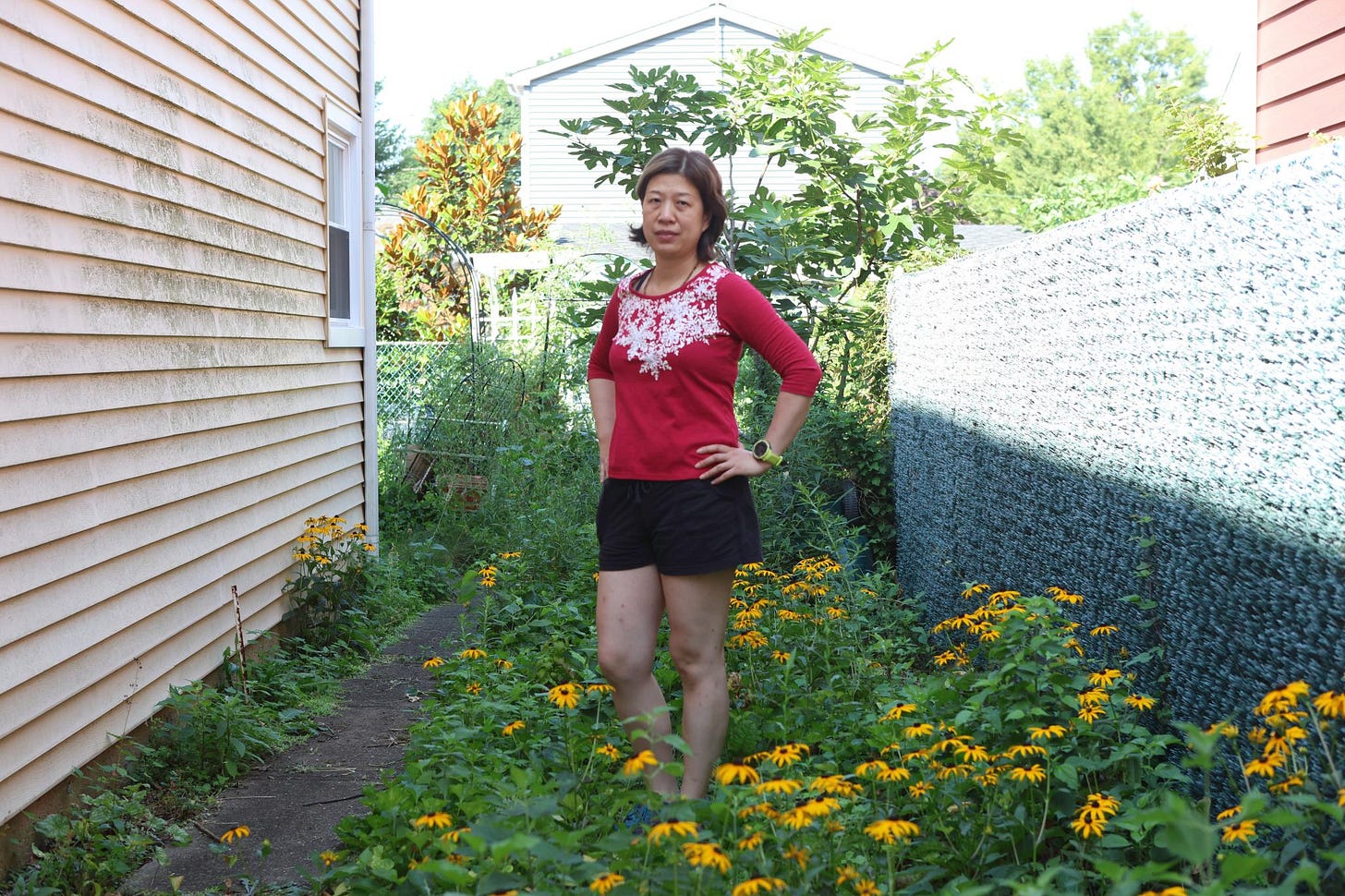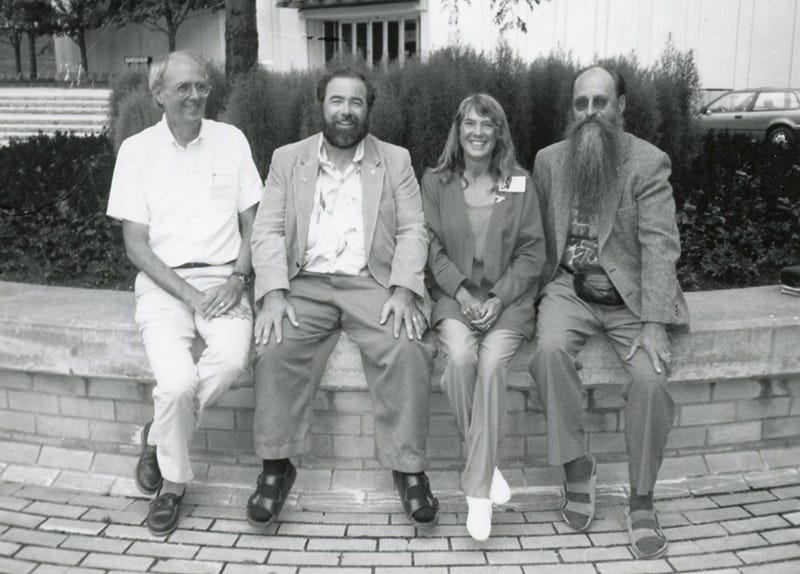The politics of the “perfect” yard
Why messy abundance is punished, curated rewilding is celebrated, and conformity still rules the ground beneath us.
In New Hyde Park, New York, Xilin Zhang tore up her front lawn and planted a garden of native species. Butterflies came, birds came, bees came. Then the village officials came, carrying a summons and the threat of a $2,000 fine.
Zhang put up a sign to explain this was intentional, not neglect. She wanted a landscape alive with pollinators, one that supported the aquifer and restored the ground. To her, the garden wasn’t just beautiful, it was the right thing to do.
Anonymous neighbors and the mayor evidently disagreed. “Hideous,” they said. A violation of the village code. Mayor Christopher Devane declared that “when ugly is that overwhelming, you have to call it what it is.” After four rounds in court, Zhang was finally allowed to keep the garden, but only if the tallest plants were relocated around the side of the house and everything else is kept trimmed below four feet.
It is a strange measure of civilization that a mayor can publicly shame a woman for growing milkweed, while developers a few miles away pave over farmland and call it growth.
Lawns, it turns out, have never been neutral. In fact, they are among the most enduring tools of conformity in the modern world. In Britain, the manicured lawn began as an aristocratic display of wealth, a way to show that your fortunes were so vast you could hire an army of laborers to scythe the grass just for show, with no thought to productive cultivation.
By the nineteenth century, the lawn mower democratized that aesthetic, and the middle class adopted turf as a badge of respectability. In America, the prototypical suburb of Levittown, NY — not far from where Zhang faced down her village — galvanized the mowing of lawns into the American Dream. A perfect, tidy lawn became symbolic of belonging, a signal that you had a moral code, were disciplined, and believed in being part of the crowd. A messy yard meant trouble and lower property values all around.
That code still rules. In Michigan, a woman faced jail time in 2011 for planting vegetables instead of grass. In Florida, a couple fought city hall for six years over an edible garden they were forced to rip out. Beauty, it seems, is in the eye of the Home Owners Association (HOA).
While towns are punishing residents for letting grass grow too long, glossy magazines and NGOs are euphemistically celebrating “rewilding” as the garden trend du jour. In 2024, House Beautiful assured readers that meadow-style yards were the look of the year. Chatelaine offered its readers a how-to guide for rewilding a lawn that included the advice to talk to your neighbors and explain your intentions. USA Today recently praised suburban experiments with wildflower corridors as a response to flooding and habitat loss.
The contradiction is glaring. Individual acts of rewilding are suspect because they resist conformity; institutional rewilding is celebrated because it can be curated, managed, and photogenic. Not to mention picture-perfect virtue signaling, too.
This echoes what William Jordan, one of the first philosophers of ecological restoration, observed in the 1970s. Working at the University of Wisconsin Arboretum, he described restoration as a kind of performance — a stage where humans could act out their dependence on the living world. Planting seeds, rebuilding prairies, and tending restored land were rituals of humility, dramatizing the fact that we live only by consuming other life.
Rewilding is still a performance, but the focus has simply shifted. Where ecological restoration once enacted humility, today’s rewilding enacts branding and solicits ‘likes.’ The stage is no longer a prairie but a glossy magazine spread or Facebook post. The actors are no longer volunteers but grant managers, consultants, and social media influencers. The work is not a confession of human limits, but a stage-managed production of a wildness that reassures, inspires, and can be posted to Instagram without threatening property values.
This illustrates the delusion of our culture: we claim to want wildness, but only if it comes in curated packages. A wildflower corridor is fine in a highway median, but it’s a nightmare in your neighbor’s front yard. Karen from the HOA will not stand for messy abundance if it doesn’t conform to standards set by the editors at House Beautiful.
And yet messy abundance is exactly what collapse requires. Fertilizers and herbicides will vanish, water bills will rise, manicured lawns will fail. The cultural code will demand order and sterility long after those become impossible. The landscapes that survive will not be the ones manicured into submission, but the ones left to grow — stubborn, weedy, unapproved.
In the years ahead, Xilin Zhang’s garden may be the one that shows us how real life returns to our urban and suburban constructs.



![Mowing the lawn in one of America's first suburbs, Levittown, PA 1957 [976 x 549] : r/HistoryPorn Mowing the lawn in one of America's first suburbs, Levittown, PA 1957 [976 x 549] : r/HistoryPorn](https://substackcdn.com/image/fetch/$s_!XH4p!,w_1456,c_limit,f_auto,q_auto:good,fl_progressive:steep/https%3A%2F%2Fsubstack-post-media.s3.amazonaws.com%2Fpublic%2Fimages%2Fe615a013-25b8-4ef5-a596-f64b6edfcc04_976x549.jpeg)

It is complicated to pin down. The requirements and "approved" landscaping come from different sources. There are many things that they are trying to address.
There are the obvious issues of the "aesthetics" and perceived impacts on property values.
The yards that attract butterflies and flowers for bees to pollinate are wonderful but when they harbor rats and other pests, not so much. There are problems as to risks of fires. There are problems of properties being used to hide illegal activities. The rules for how much of a property is paved over for instance are part of flood control. There are also rules for how many trees a property has in its landscaping hoping to fight heat islands that are formed by cities.
There are problems with the conflict of property rights. Besides just what you can do on your own property, there are the effects on neighboring properties. It isn't cut and dried as different people have differing opinions on what is "natural" and what is "derelict."
One of the biggest problems is that many HOAs and local governments use boilerplate regulations that are not specifically tailored to the local environment. They are not taking into consideration any unusual conditions such as water restrictions imposed by drought conditions. It is especially bad when they create rules to maintain a manicured green lawn in the middle of a freaking desert such as you see in parts of California, Nevada, and Arizona.
Peter Wohlleben a forest ecologist from Germany has written many books describing the intricate hidden communications of trees and their astonishing interconnections with the web of life. His profound insights reveal how ancient forests sustain themselves, moderate weather and are key to the survival of every species. He advocates for preservation of ancient forests before the store of "tree knowledge" and adaptability is gone.
In my view we need to heed that warning, preserve forests with minimal disruption, but also reimagine farming and gardening so it's more in tune with nature. City folk and most humans I suppose won't want to accept true wildness. So maybe it should be a compromise where we decide to minimize negative and highly destructive but profitable protocols in favor of regenerative and healthy practices. It won't be easy to turn the profit driven ships around but it's looking like a shipwreck.
I try to live by my principles, with an organic garden, and I refuse to condone anything that harms even tiny microbes in the soil. But I have to "curate" my yard, trimming and weeding and cutting. I soon learned that I couldn't go too "wild" and I needed to plan ahead and shape the landscape with moderation and common sense in tune with nature. It's a learning curve for me but it's rewarding in many ways.